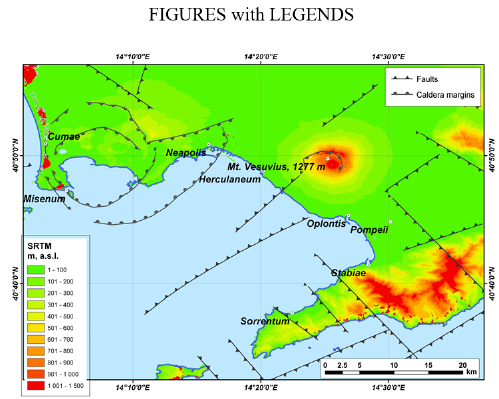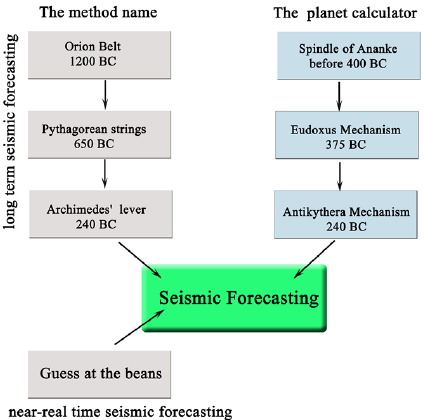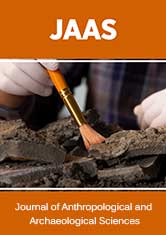
Lupine Publishers Group
Lupine Publishers
Menu
ISSN: 2690-5752
Research ArticleOpen Access 
The Archimedes’ Lever and Vesuvius Eruption A.D. 79 Volume 1 - Issue 4
Alexander N Safronov*
- AM Obukhov Institute of Atmospheric Physics, Russian Academy of Sciences, Russia
Received: February 07, 2020 Published: February 24, 2020
Corresponding author: Alexander N Safronov, AM Obukhov Institute of Atmospheric Physics, Russian Academy of Sciences, Pyzhevskii, Moscow, Russia
Abstract
The study based on detailed analysis of the Villa of the Mysteries frescoes, which were discovered early at the excavations in Pompeii. It was shown that the Villa of the Mysteries is a school of priestesses-seismologists. It is established that the frescoes depict the process of priestesses introducing in the Hera seismoacoustic cult (Zeus-Hera-Dionysus cult). It is shown that in the Hera cult the wand strike on the back of the graduate priest student symbolizes the fact of the introduction of the priestesses to the priesthood. The comparison between Pythagoras School in Crotone, Southern Italy (Temple of the Muse) and Cumaean Sibyl seismoacoustic at margin of Campi Flegrei, Gulf of Naples and school at Villa of the Mysteries, Pompeii was carried out. Some caustic remarks about interpretation of Homer and Lion Hunting were written. It is shown that Archimedes’ lever principal is theoretical basis of the Roman Empire volcanology and seismology. The Archimedes’ lever principal of planet alignment was demonstrated in several examples of the large up-to-date explosive eruptions with Volcanic Explosivity Index (VEI) greater than 4+ (6 examples). It was noted that the Pythagoras-Plato gravitational waves (vortexes) were known in Europe since Thales of Miletus and Pythagoras.
Keywords: Pompeii; Vesuvius; seismoacoustic; Archimedes’ lever; Antikythera Mechanism; planetary alignment
Introduction
The crisis came into the science from the side where no one expected it. The planetary frequencies have been recorded in the current climate trend of temperatures and they were confirmed by many groups of researchers. On the other hand, the up-todate astronomy, based on the Einstein theory, cannot explain the existence of such two-year and 11-year climate cycles in the temperature trend. Thus there is the deepest crisis between astronomy on the one hand and geosciences: meteorology, climatology, volcanology and seismology, on the other hand. An attempt to explain phenomena by using the oldest Pythagorean- Platonic doctrine encounters that some of scientific communities does not recognize at all the Pythagorean-Platonic philosophy. All it has created the prerequisites for a writing this discussion article.
Note that at the process of the society evolution the Pythagorean- Platonic cosmology underwent changes, and during the Roman Empire it was more know as the Lever Principle of Archimedes. Let’s ask a question: how does the historical science represent the Pythagorean-Platonic cosmology? The answer to this question is paradoxical. The Pythagoras cosmology is a logically unrelated amorphous mosaic of such fields of knowledge as music, geometry, geography, astronomy and religion. Without understanding the essence of the research object, modern historians run into the dogmatism, which was not peculiar to the Ancient Philosophy. Nevertheless, these fields of knowledge are connected by the object of study. Such object is the Ancient Seismology and Volcanology. As an object of the study, it was possible to choose any seismic or volcanic events in the past. So, the dramatic event of the Vesuvius eruption A.D. 79 was chosen in this study. Below it is demonstrated that the Ancient Philosophy is externally pragmatic.
As it is well known the Vesuvius is an active solitary volcano located in the south of Italy on the coast of the Naples Bay (40.818ºN, 14.439ºE). At the present the height of the volcano is 1280 m, the diameter of the crater is 750 m, and the crater depth is 200 m. The volcano has several cones; the outer one is oldest and it has own name the Somma. The basic volcanic cone of Vesuvius is composed of interbedded layers of lava and volcanic tuff that after weathering provide soil fertility on the volcano slopes. In the lower sites of Vesuvius slopes and nearby of volcano there are many vineyards, which make a basis of Pompeii winemaking industry. There are more than 80 eruptions of the Somma-Vesuvius, some of which were accompanied by the collapse of the caldera. In different periods of history the various types of Vesuvius eruptions were observed, including explosive eruptions, effusive eruptions, and mixed effusive-explosive eruptions. The most known volcanic eruption has occurred on 24 August A.D. 79, which has been described by Pliny Young and Suetonius Tranquillus. The 79 AD Vesuvius eruption is refers to the Plinian eruption type (pyroclastic eruption type), which named in honor of the famous Roman writer and researcher Pliny Eld, who died during this eruption. In the process of the Vesuvius AD 79 eruption it is necessary to allocate the periods, when the mixture of hot volcanic gases and tuff particles created the fast and devastating streams, known as pyroclastic flows, which propagate along the volcanic slopes. Exactly these periods of eruption correspond to the periods with production of landslides, mud flows and caldera collapses. In this study, we do not insist that the eruption of Vesuvius occurred at 24 August; however, below we show that the arguments about the eruption dating at the 24 October are not sufficiently convincing [1].
Before of the Vesuvius eruption, A.D. 79 the strongest earthquake occurred at A.D. 62. This earthquake severely destroyed Pompeii and also affected to the Vesuvius cone. This earthquake has created the prerequisites for the caldera collapsing in A.D. 79 and for the pyroclastic flows rising.
As a result of the Vesuvius eruption A.D. 79, the ancient Roman cities of Pompeii, Herculaneum, Oplontis and Stabiae were destroyed [2]. Herculaneum was destroyed by volcanic mud flows, and the inhabitants of Pompeii, Oplontis and Stabiae have suffered by pyroclastic flows. The houses in Pompeii, Oplontis and Stabiae were also covered with volcanic ash, which gradually filled them up to the roofs. The destruction of houses in Pompeii was investigated by Luongo et al [3]. The thickness of the pumice-rich pyroclastic deposit was totaling to 280cm [4]. Mastrolorenzo et al. shown that the fourth pyroclastic flow destroyed Pompeii [5]. The temperature in pyroclastic flow was rise up to 300°C and more, that was enough to kill hundreds of people in a fraction of a second. The pyroclastic flow instantly killed the Pompeii’s inhabitants and the fallen ash covered their bodies, so the bodies of the victims in Vesuvius remained sealed in volcanic ash cast.
This study is devoted to seismoacoustics in Rome and is an extension of the study: Antikythera Mechanism and the Ancient World, covered temporal period 650 B.C.-50 B.C. [6]. In this study it is shown that Roman seismoacoustics (Zeus-Hera-Dionysus cult) inherits from Hera cult and Pythagorean-Platonic cosmology evolved from Ancient Greek. This part of study can be of interest for Roman historians.
Further we discussed about Archimedes sculptures and Archimedes’ lever principle. The Archimedes’ lever principle are demonstrated by examples of the strong volcano eruptions with VEI>4+ (6 examples). This last section may be of interest to astronomers, volcanologists and seismologists.
Methods and Materials
Historical sources
The following historical sources were carefully analyzed in this study: two letters of Pliny Younger (Gaius Plinius Caecilius Secundus) [7,8] and «The life of Pliny” of Suetonius Tranquillus [9]. The plan of Pompeii with a spatial distribution of the human casualties was used from study of Luongo et al. [3]. The room plan and the interpretation of the rooms of Pompeii Villa of Mysteries (Villa dei Misteri) were based on investigated of Amedeo Maiuri [10]. The description of the Antikythera Mechanism can be found in our previous publication and references [6].
Astronomical dataset
The study used the principal of linear configuration of planets, which also were called early as planet alignment and Archimedes’ lever. For this, in the present work the Orbit Viewer java applet was using [11]. It was created by Osamu Ajiki (AstroArts Inc.) in 1996 and then modified by Ron Baalke (NASA/Jet Propulsion Laboratory, below JPL) in 2000-2001. The original Orbit Viewer is an interactive applet that displays the orbit of the small bodies such as comets and asteroids in the solar system in 3D projection by using NASA JPL Small-Body Database Browser [12]. The orbits may be shown forwards or backwards. This applet Orbit Viewer has been adapted to measure the angles between the planets of the solar system and to find the proportions in the planet positions. In this study the following abbreviations were used: Mercury-Mr, Venus-V, Earth-E, Mars-M, Jupiter-J, Saturn-S, Uranus-U, Neptune-N.
The planets, which are located along the line, are marked as Planet1 -Planet2 -Planet3, in the order of the distance from the Sun. The calculation of the angle (in degree) between the three planets was made when the vertex of an angle is placed on the more distant planet. For example, the angle for the linearity of JEV is the smaller angle between the two lines of JE and JV. The ratio of the distances between the planets was designated as Planet1 Planet2 / Planet3 Planet4. For example, the ratio of the distance between Saturn and Earth to the distance between Earth and Venus was denoted as SE/ EV.
The datasets of volcanic eruptions
It is well known that the intensity of volcanic eruptions is well described by Volcanic Explosivity Index (VEI) [13]. In this study the volcanic eruptions with VEI more than 4 were included. Note that the eruption with VEI > 4 corresponds to tephra volume with size more 0.1 km3, cloud volcanic column height is more than 10 km a.s.l. (above sea level) and continuous blast is during more than 12 hours. The volcanic data were obtained in Siebert, Simkin and Kimberly [14] and in materials of Smithsonian National Museum of Natural History [15].
Results
Vesuvius eruption features
The process of the Vesuvius eruption A.D. 79 was started in the airfall ash phase. We know in details of this stage of eruption by the Pliny Young and Suetonius historical descriptions. At first, Pliny Young gave a fairly detailed description of the volcanic cloud, which he observed himself, while being on the naval base in Misenum. The general map of the relative locations of the cities on the Neapolis Bay was presented in Figure 1. The distance between Misenum and Mount Vesuvius is equal to 29km; the distance between Misenum and Stabiae is 35km (Figure 1).
The Somma-Vesuvius and Campi Flegrei calderas margins and faults were presented in Figure 1, and in Orsi et al. [16] and Aulinas et al. [17] studies. The Campi Flegrei caldera circle was located nearby Cumae-Misenum. The timing and compositions of volcanism at the Somma-Vesuvius, Ischia, Procida and Campi Flegrei, within the Campanian area were investigated by Vito et al. [18].
In particular, in these studies it is shown that the period of activity of Campi Flegrei corresponds to the period of Somma- Vesuvius calm. The .historical eruptions at Campi Flegrei took place during the period of 2800 - 1800 BC, that is much earlier than the period of Pythagorean-Platonic cosmology during 650 B.C.-50 B.C., [6]. Note that the Cumaean Sibyl tunnels and halls are well preserved. Additionally, we note that, despite the fact that Cumaean Sibyl is located near Somma-Vesuvius, this seismoacoustic complex belongs to Campi Flegrei caldera, that is, it could not be using for the needs of Pompeii. In this situation, it can be assumed that in “Sur les Oracles de la Pythie” Plutarch [19] wrote not about the Delphic Sibyl, or about Sibyl in general, he wrote specifically about the Roman Sibyl and first of all about the most famous in Roma the Cumaean Sibyl.
Thus, it can be concluded that Plutarch was referring to the inability of Cumaean Sibyl to predict the largest in that historical period Vesuvius eruption at A.D. 79. The Cumaean Sibyl tunnels and hall themselves were built in the immediate vicinity of the caldera and are an ideal place for seismoacoustic surveys nearby Cumae. In general, it is clear that after the strong earthquake A.D. 62, which partially destroyed the Pompeii, there was a need to create its own seismoacoustic school in Pompeii.
Return to investigation of the Vesuvius eruption at A.D. 79. In the letter “To Cornelius Tacitus”, LXVI Pliny Younger wrote: “A cloud, from which mountain was uncertain, at this distance (but it was found afterwards to come from Mount Vesuvius), was ascending, the appearance of which I cannot give you a more exact description of than by likening it to that of a pine tree, for it shot up to a great height in the form of a very tall trunk, which spread itself out at the top into a sort of branches; occasioned, I imagine, either by a sudden gust of air that impelled it, the force of which decreased as it advanced upwards, or the cloud itself being pressed back again by its own weight, expanded in the manner I have mentioned; it appeared sometimes bright and sometimes dark and spotted, according as it was either more or less impregnated with earth and cinders. This phenomenon seemed to a man of such learning and research as my uncle extraordinary and worth further looking into.”
An explanation of this description was simple if using methods of volcanology. The air-fall pumice and the ash are the most widely spreads of type of deposits, resulting from a high eruption cloud downwind from the volcano eruption. Depending on the relative position of the observer, the volcano caldera location and the wind direction in the upper troposphere, this type of eruption forms three characteristic pictures that can be described as “Flag”, “Atlanta” or “Pine tree”. The tropopause, which located between the troposphere and the stratosphere, prevents of a micron and submicron volcanic aerosol deposition, so the tropopause forms the characteristic shape of the plume.
Note that “Two Atlantes hold the sky on stone hands”-a poetic description from Homer of the phenomenon, formed by two not so strong eruptions [20]. Note that original author was Moses at 12 century B.C., and poems were re-written by Greek poetess Helen (Evenus) of Paros at 4 century BC, [6]. Modern GPS systems show the location of the “Atlantes” with high accuracy. Such volcanoes are located between Sicily and the northern coast of the Africa. Now these volcanoes are not active and are located at shallow depths. These underwater volcanoes Campi Flegrei del Mar (Phlegraean Fields of the Sicily Sea), with coordinates 37.10°N, 12.70°E, at 8 m below sea level [6]. The example of Atlas formation in the volcanic column during the Puyehue volcano eruption, 05.06.2011, Chile was presented in Figure 2. The ash column rose up to 10-15 km height and forms an object which looks similarity to Atlas hold the sky on stone hands (Figure 2).
Figure 2: The example of Atlas formation in volcanic column at eruption of Puyehue Volcano, 05.06.2011, Chile. The ash column rose up to 10–15 km height. The photo image obtained from Volcano Catalog. With some imagination, the image of the mythical Atlanta, holding the sky above head, can be recognized in the plate.
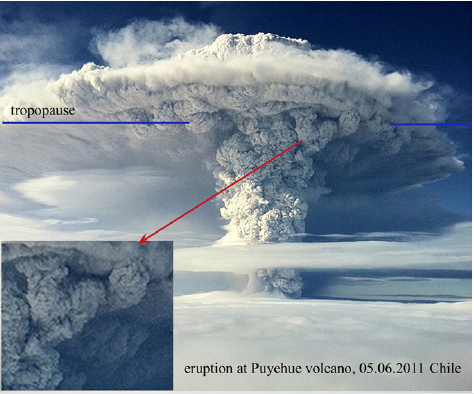
At the Vesuvius eruption A.D. 79 the shape of the “Pine tree” form of a volcanic column was observed, therefore at the beginning stage the eruption should be characterized as an eruption with the small power. The ashes and pumice have been lifted only on the height of the tropo pause (12-15 km). Note that the ash fall deposits/ which fall down from volcanic cloud, strong depended from wind direction and volcanic column altitude, but pyroclastic flows, which slide down at the volcano slopes, weak or at all not depended from the wind direction.
Further the pyroclastic flows were a second type of deposits at A.D. 79 eruption; about details of Plinian and subPlinian eruptions [21]. The eruptive column switched at least six times from fully buoyant to partially collapsing, fully collapsing, and boil-over conditions, generating alternations of ash fall and PDC deposits [22]. This deposit does not depend on a wind direction and it is characterized by a hot stream of pumice, ash and gases which flow down the on a slope of a volcano. The accurate numerical simulation of pyroclastic surges and flows (PDC) for the fourth A.D. 79 Vesuvius pyroclastic flow (P4) can be found in Mastrolorenzo et al. [5]. The simulation was made by using the model of a gravitydriven pyroclastic current. At P4 eruption the dynamic overpressure was equal to 1 kPa; the temperature in pyroclastic stream reached at least 250°C; the thickness of flow was equal to 18 m; flow velocity ~ 29 m/s. According to Shea et al. [23], the time of six PDC eruptions is P1 (8 p.m.), P2 (1 a.m., the next day), P3 (2 a.m.), P4 occurred at ~ 4 a.m. and P5 and P6 in the interval of 5-7 a.m.
At the end of this section we made one more remark about Pliny the Younger letters (“LXV-To Tacitus”: “As he was coming out of the house, he received a note from Rectina, the wife of Bassus, who was in the utmost alarm at the imminent danger which threatened her; for her villa lying at the foot of Mount Vesuvius, there was no way of escape but by sea; she earnestly entreated him therefore to come to her assistance.”
Who is “Rectina, the wife of Bassus” and why is nothing known about her? In his letters Pliny Younger several times referenced the name of Bassus, namely he wrote about Aufidius Bassus in letter (“XXVII-To Baebius Macer”), about Gabius Bassus in (“XXVIII, XXXII - To The Emperor Trajan”), (“XXXIII - Trajan to Pliny”), and about proconsul Julius Bassus in (“LXIV — To The Emperor Trajan”), (“LXV — Trajan to Pliny”). In all cases, except for the letter (“LXV-To Tacitus”), mentioned above, it was clear which member of the genus Bassus was talking about.
At the Pliny Eld lifetime it is well known Gaius Laecanius Bassus who was Roman consul at A.D. 64 together with Marcus Licinius Crassus Frugi. The Gaius Laecanius Bassus (consul, A.D. 64) adopted Gaius Laecanius Bassus Caecina Paetus, which father Aulus Caecina Paetus was forcedly made suicide by Nero. Further Gaius Laecanius Bassus Caecina Paetus have son Gaius Laecanius Bassus Caecina Flaccus, which was grandson of well-known Gaius Laecanius Bassus (consul, A.D. 64) and have his family name. This young man got position of triumvir monetalis and was responsible to mint coins.
From other hand it is known the unusual silver coin was found in Pompeii (P 14312/176) in the House of the Gold Bracelet (Insula 17, 42) at June 3-6, 1974; now this coin preserve in the National Archaeological Museum of Naples. This coin indicates the 15th imperial acclamation of Titus (IMP XV). The numismatic index of this coin is Pompeii Denarius RIC 37. Also this Coin called as “Inconvenient” Coin. Why this coin has received such name? Rolandi et al. in [1] indicated that the 14th imperial acclamation (IMP XIIII) dated at 7th and 8th September A.D. 79. Therefore, according to Rolandi et al., the Pompeii Denarius RIC 37 is surely struck after 8 September A.D. 79. However according to the Pliny Junior volcano Vesuvius erupted before this data, on 24 August.
However the “Inconvenient” Coin has no traces of money circulation (there are no scratches and abrasions), also there is no edging on the coin and the quantity of same stamping plate coins (Denarius RIC 37) is extremely limited, no more than three. It can be concluded that the “Inconvenient” Coin was a trial coin. Also we will remind that from one hand in Pompeii it never was an imperial mint, but on the other hand we look for triumvir monetalis or his relative this who can own this coin in Pompeii and/or person with Bassus family name. We believe that we found the women who wrote letter to Pliny Eld. Also we believed that Pliny Eld was head of “aerarium sanctum” so friendship with triumvir monetalis was very important to him. Pliny Eld was a professional military, so writing manuscripts such as Nature was not hobby of Pliny Eld himself; it was official duties for head of “aerarium sanctum”.
Was either Pliny Eld waiting Bassus’ family in the Stabiae or galloping to Bassus’ house in Pompeii? This question requires the victim identification and it stays out of scope of this study. Only remind that during excavated in (Insula 17, 42) it was revealed 4 corpses (2 children and 1 woman) and one more man with unpublished status, [24].
The Zeus-Hera-Dionysus cult on the wall painting on Villa dei Misteri
There are a lot of houses in Pompeii; however, but one is very unusual house, called as Villa dei Misteri (40.754°N, 14.477°E). This Villa located outside Pompeii, nearby the north-west gate of Pompeii (“Porta di Ercolano”), see map of Pompeii (Figure 3).
Figure 3: The plan of the Pompeii, according (Luongo et al., 2003).
Numbers: (1) – Villa of Mysteries; (2) – House of the Gold Bracelet (Regio VI, Insula 17, 42).
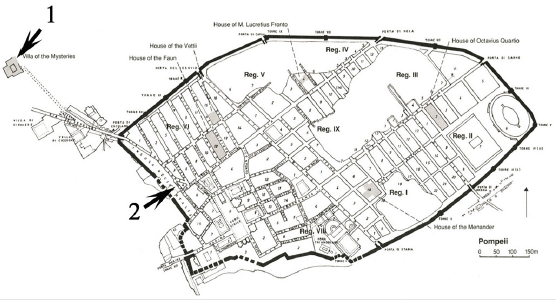
The Villa stood remotely from other Pompeii’s buildings; the west side of building was adjacent to the bedrock; a great view on the Mont Vesuvius was offers from this Villa. However the location of Villa dei Misteri was less successful than the above-mentioned seismoacoustic station of Cumaean Sibyl (Figure 1).
We will pay attention to the interpretation of the wall painting in the room 5 of Villa dei Misteri, known as Room of Mysteries. This room got the own name as the Room of Mysteries due to the walls of this room are simultaneously decorated by images of the real people, who lived in Pompeii, and by scenes of Greek mythology of the Zeus-Hera-Dionysus cult, see Figures 4&5.
Figure 4: The frescoes on two adjacent walls in the Room of Mysteries (a, b) were presented. The frescoes correspond to the priestess initiation at the Greek cult of Hera (a cult of acoustic seismology).
Numbers: 1 – a torch for illumination in the dark seismoacoustics tunnels/caves; 2 – Dionysius screen, the symbol of the near real forecasting; 3 – gesture of the angel’s hand rejecting the Dionysius screen; 4 – phallus, symbolizing the love joys of Zeus (Jupiter) and Hera (Earth), size of its is analog of the Richter earthquake scale; 5 – blow by a whip, characterizing the suddenness and short duration of seismic processes; 6 – the graduated student priestess; 7 – nurse of the student priestess; 8 – a naked priestess, engaged in music (acoustics) practice in the dark tunnels/caves. 9 – Tambourine wedding dancing also called as Remoh dancing with two stars.
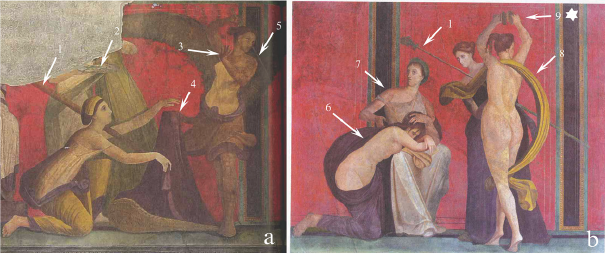
Figure 5: The fragments of other frescos in the Room of Mysteries (a, b) were shown. The studying of a young priestess, which is depicted as a young Dionysus (see her shoes), was presented on (a). The leader of the priestess’s school is depicted on the fresco (b).
Numbers: 1 – earring; 2 – ring; 3– bulk gold bracelet; 4 – probably the Antikythera Mechanism (using for longtime seismic forecasting) covered with green tissue. Note that the jewelries are suitable for bodies’ identification. The particular interest for us represents the gold bracelet (3); the similar bracelet has been found in the excavation of the House of the Gold Bracelet (Pompeii, Regio VI, Insula 17, 42).
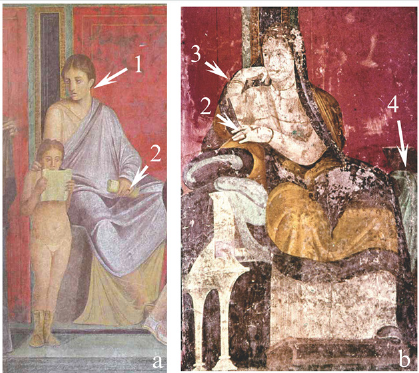
The wall painting was made after a strong A.D. 62 earthquake, so the probability that the images of the real persons suffered at the Vesuvius eruption A.D. 79 were represented on the wall frescoes, is high. It is well known that in the days of the Roman Empire (Republic) the Greece education was very good and famous, especially before the defeat of the Academy in Athens at Sulla time.
Therefore, often the Greeks were invited in Roman houses as teachers. Thus, we can conclude that the small professional (priest) school was located on the Villa dei Misteri. It is confirmed by Figure 6a, in which a child, shod in the Dionysus sandals, was trained on a scroll. As on wall the Greece cult was represented, so it is possible to assume that wall painting was made after the destruction of the Second Temple in A.D. 70 in Jerusalem, i.e. wall painting was done the nine years before of volcano eruption.
The pieces of the wall frescoes interesting for us are shown in Figures 4&5. These frescoes are located in the corner of the room and represent a uniform composition. The presence on the frescoes of the Hera cult specifies that the seismologist-acoustic priestesses graduated this priest school. In the Ancient World the seismic oscillations of Earth core were converted into the acoustic oscillations, which were recorded by seismologist-acoustic priests (priestesses) in the caves or specially cut shafts located nearby the seismic faults, [6].
It is of interest to compare the school in Pompeii ~ A.D. 70 with the Pythagoras School in Crotone, in the Southern Italy (located in the Temple of the Muse). We will remind that Pythagoras School was located on the continuation of the V-shaped geological fault on the coast of Italy in the territory of the Greek colony [6]. Comparing these two schools, it is necessary to note that the school in Pompeii is very small. The number of graduates of the Pythagoras School was exceeded by several hundreds persons. On the wall of the Villa dei Misteri, there are only two schoolgirls. One of whom, represented in the form of young Dionysus, had to be trained at school at least 7 more years.
The wall composition on Figures 4a&4b represents the solemn moment when the schoolgirl was introduced to the priestessseismo acoustics (seismologists) status. The graduating student is represented on Figure 4b as bowed (6), burying herself on the knees of her wet nurse (7). The maid in the image of the Angel, depicted on the next wall (Figure 5a), is going to strong strike on the back of the graduate schoolgirl by a stick. The impact of the stick symbolizes the natural strikes, which the unfortunate girl will be suffering in future. Note that the priestess-seismologists were forbidden to leave their cave or mine. They, being in the mines or in the caves near volcanoes and seismic faults, should with improbable courage keep of the ongoing seismic processes and warn the inhabitants about earthquakes or eruptions hazards. Many of them were overwhelmed by stones in the caves and in the mines, as well as often the priestesses perished, poisoning by volcanic and seismic gases. Although the event, displayed on the wall, occurred during the light time, the torches are shown in the hands of servants (see Figures 4a&4b). This means that the young priestess should go down into an underground vault, in the world of Aida. The naked woman musician (8) with a ribbon tied to her right leg could be seen on Fig.4b. It is not excluded that the priestesses went to the naked, oiled, with a long safety belt or a rope, tied to their foot. In earthquake or volcanic eruption the caves/stulm start filling with volcanic or seismic gases, one dragged out them from the cave for a safety belt. At emergency pulling out, the priestess’s clothes would be obstacles in the way, as it could be hooked on the ledges of the rocks.
In Greek mythology, the process of a natural earthquake is represented as the violent love of Zeus with terrestrial women (Hero). On the frescoes (Figure 4a) the servant removes a cover from a Zeus phallus; its size is colossal. The hand of the servant is slightly raised, which symbolizes the process of a powerful earthquake. Analysis of the frescoes, conducted by Lehmann et al, showed that the servant hand was redrawn and lifted little up, which symbolizes the prediction of the earthquakes/eruptions [25]. Above, on the damaged part of frescoes (Figure 4a), another servant, which holds a seed screening (Dionysus screening, Dionysus rumble), was represented. Usually the Dionysus screening is filling by different sized grains. In Ancient Word depending on which size grains start to move, the power of seismic activity was defined. This technology of seed screening has been used during many centuries and was widely applied in the Middle Ages as mine protection of fortresses. For this purpose in the acoustical halls, which were located regularly underground along the fortress walls, the army drums were established, on which the grains, seed or gun fractions were scattered over.
It is known Pythagoras expression: “do not guess at the beans”, which most likely means the following: at moving large grains on surface of Dionysus screening, such as a bean, you should immediately leave the seismoacoustics caves/tunnels. It is interest of note that the gesture of Angel’s hand on Fiure 4a seems as it rejects using of Dionysus screening, i.e. rejects the nearreal time seismic forecasting.
In the Roman Empire there was a bitter confrontation between the supporters of the Egyptian cult of Isis and the Greek cult of Hera [6]. In the last year of Cicero’s life, the Isis cult began to dominate in Rome, more precisely it was not the ancient cult of Isis itself, but was a somewhat modified Egyptian-Jewish cult of Isis. However, after the burning of Rome during the reign of Nero, as well as during the Roman-Jewish wars, in Rome the Greek cult of Hera again became dominant. As well as in the case of the Isis cult, the Hera cult was modified in the Zeus-Hera-Dionysus cult. Therefore, it should not be surprising that in some villas nearby of Vesuvius only the Isis cult was found, and on some a cult of Hera was presented. This is determined by the time of building the villas and the views of their owners.
Note one more feature. A naked priestess is dancing in the dark tunnels/caves in Figure 4b. The safety-signal rope is tied to the priestess foot to provide safety working in tunnels/caves. She holds it two tambourines in hands over the head. Though details of tambourines in fresco are not visible, but we know that it is two six-ray stars. Thus it is tambourine wedding dancing also called as Remoh dancing with two stars.
Below we wrote some words about Remoh dancing with stars. According to Titus Flavius Josephus throughout the Second Temple Period in Jerusalem there are four sects (groups) of Jews: Sadducees, Essenes, Pharisees and not numerous Therapeutae (mostly natives from Alexandria). From the point of view of Rome, these groups can be characterized as Picours, Pythagoreans, Stoics and Thebes, correspondingly. Essenes were well-educated and were followers of the teachings of Moses; also it is known about Essenes astronomical and religion school at the region of Dead Sea. Whereas Sadducees were grouped around Temple Priests; they were poor-educated and spend more time to given the pleasures of life. Conflicts between Essenes and Sadducees took place in the context of much broader and longstanding social and religious conflicts among Jews, made worse by the Roman conquest. At first time Pharisees took a neutral position in the religion debates, but after greatly increase of taxes they began to battle both with Sadducees and with Romans. It was very favorable to Rome to support with Moses followers. In this situation it is not surprising that Nero quoted Homer, Vespasian taught the Romans to walk on water on the arena of Coliseum, and Tit fed the lions. These are links of one chain. The Holy Court in Rome decided to support Moses and his followers and the Sadducees has lost the legitimacy of the Temple in Jerusalem. In Jerusalem the Remoh wedding dancing with six-rays stars were prohibited and were forgotten over time. Thus women in Ancient Remoh dance demonstrated the planet (star in Hebraic terminology) alignment principal.
Remind that the first author of the Homer poems is Moses (12 century B.C.) and second author of Homer poems, poetess Helen (Evenus) of Paros. (4 century B.C.). Of course Helen of Paros knew that Semitic texts are written from right to left. She represented us a simple word-play as trick: Remoh-Homer. Reader undoubtedly smiled to learn that Homer is the name of a cult Semitic dance (Remoh) with a tambourine (two six-ray stars), and accordingly it is not the name of author of magnificent poems.
The Antikythera Mechanism at Villa of Mystery
Below we will focus our attention on some aspects of the Ancient Volcanology and Seismology such as the Antikythera Mechanism and the Archimedes’ lever. The Roman seismoacoustics inherits from Ancient Greek seismoacoustic tradition as well as an Ancient Greek “Divine Music” tradition (Music Temple in Crotone), Delphi seismoacoustic tradition and also inherits from oldest Egyptian Bronze stage traditions. The general scheme of longterm and near-real seismic forecasting is presented in Figure 6.
As it can be seen from the scheme (Figure 6) the Archimedes Lever Principal as eldest the Pythagorean-Platonic cosmology (also call also as Pythagorean strings) inherits from the astronomical Orion Belt Principal. Early this principal sometimes also called as Orion-Pleiades Principal, Kesil [Hebraic Dummy] principal, Lion Hunting [after Tutankhamun died, and later under Ramesses III reins] or Architectural Principal of Giza Pyramid’s Complex. The names of method were different, but as it can be shown below the nature of effect consists of planet alignment, see Figure 6.
Similarly this Antikythera Mechanism as instrument for planet position determination was preceded by the Eudoxus Mechanism and before inherits from the manual calculator known as “spindle of Ananke”. It was established that mechanical calculators (Antikythera Mechanism) were presented as ceremonial and everyday models [6]. In the same place also it was established that during the time of Sulla’s campaign for Athens in the Platonic Academy there were even educational versions of Antikythera Mechanism. Therefore, we carefully considered frescos at the Villa of Mystery in search of one of educational mechanical calculator.
At last the leader of Pompeii Priestesses School was shown on Figure 5b. This fresco was drawn at ~ A.D. 70. In case this woman was supervisor of the school at A.D. 79. The greatest interest for us represents a box located behind the high priestess. The box was covered with green shawl (see 3, on Figure 6b). So the painter schematically depicted the Antikythera Mechanism, which was a major tool for longterm seismic forecasting [6]. Therefore, the Angel’s gesture of rejecting the near-real time seismic forecasting by Dionysus screening (see 3, on Figure 4a) in favor of a long-term seismic forecasting by Antikythera Mechanism becomes clear.
It would be nice if the Antikythera Mechanism could be presented not only on the frescoes, but also found during excavations in Pompeii at the area of Pompeii Priestesses School.
The Archimedes Lever as a Theoretical Basis of Roman Volcanology and Seismology
The Cynical Philosopher as author of Antikythera Mechanism
The Antikythera Mechanism that was found near the island of Antikythera was the third copy of the mechanism hidden in the ship’s library [6]. This copy is a “private” copy, therefore the Iversen’s argumentations about the Antikythera Mechanism was made not in Syracuse, is not convincing enough [26]. Thus the marks on an Antikythera Mechanism sides characterized only personal Archimedes opinion and corresponded to political situation at the moment of ship launching.
Note that this largest ship was built by Hieron, the tyrant of Syracuse [6]. When the ship descends to the water it was called as ‘The Syracusan’; but when Hieron sent it to sea, he altered its name and called it ‘The Alexandrian’. This vessel has three masts, one of which was incredibly high. It is well known that only one of the ports in the Mediterranean had restrictions on the mast height and this port was Rhodes, one of the largest ports in Asia Minor. The sculptor Chares of Lindos constructed the Colossus of Rhodes in 282 B.C., which stand at enter of Rhodes port. Thus, this vessel, which was build by Archimedes, could not enter Rhodes port due to highest front mast. It is possible to make the careful assumption that Hieron, the tyrant of Syracuse, suggested that the Antikythera Mechanism could be used on Rhodes, however, insidious Archimedes made so that the ship could not enter into port.
As it was known from Canopus Decree (6 March 238 B.C.) at the beginning of the reign of Ptolemy III Euergetes it was necessary to transport the large quantities of grain [27]. This allowed to accurate dating of ship creation. Thus, vessel building should be dated ~ 244 BC, or more accurately 245-243 B.C. [6].
Further, let’s consider what events took place in Greece in 245- 243 B.C. and why the ship’s departure along the Syracuse-Rhodes route was canceled? In 245 B.C. Aratus of Sicyon was appointed Strategos of the Achaean League. At the time, the Achaean League’s major rivals were Macedonia, who had garrisons throughout the Peloponnese, and the Aetolian League, which had formed a military alliance with Macedonia. Corinth, which was a key city to controlling access to the Peloponnese peninsula, had been garrisoned years before by Philip II of Macedonia. In 243 B.C. Aratus as Strategos led 400 men to Corinth through the secret passage in the walls. The Macedonians were overwhelmed by the assault and the next morning Corinth’s garrison surrendered. After the Corinth Aratus defeated the Argos, the city nearby Corinth, Macedonian soldiers helped Argos and Argos returned to tyrannical rule again.
Further, according to Iversen, the Antikythera Mechanism could be applied for calculation of the sixth set of games on the Games Dial are the Halieia of Rhodes; also the Antikythera Mechanism can be used as the Epirote calendar (Northwestern Greece), possibly later be adapted for using in Corinth and Ambrakia [26]. Some marks on side have relation to the Games Dial of the Isthmia at the Isthmus of Corinth; the Olympia of Elis and the Nemea of Argos in the Peloponnese; and the Pythia of Delphi and Naa of Dodona in Epiros. Therefore Archimedes initially suggested using this giant grain-vessel on the shorter routes of Syracuse-Ambrakia, Syracuse- Corinth and/or Syracuse-Argos, instead of vessel using on the long routes, such as Syracuse-Rhodes and Syracuse-Alexandria (Syracuse-Knidos), but war on Peloponnese peninsula corrected his plans.
In this way, there is no wonder that the unknown Rhodes sculptor at Mediterranean war has created Archimedes in the form of the Cynical Philosopher, [6]. The statue is a portrait of an elderly, bearded man, whose individual features are realistically depicted. Let’s remind that in 243 B.C., Archimedes was 44 years old. Also note that according to S. Karouzou, the head to be a work of the Rhodian school of bronze sculpture. The hair is formed in disordered curls, in contrast with the beard, which is more regular and well-combed. The unkempt appearance recalls that of a Cynic Philosopher. Why are the hair not combed, but the beard is laid in even strands? What did the sculptor want to tell us? You tell Eureka and you will be undoubtedly right. Curls on the head are wet, so are not combed. Undoubtedly, before us it is Archimedes just left a bath. The wellknown Rhodes earthquake 227/226 B.C., which completely destroy the Colossus of Rhodes, naturally solved the base of confrontation between Rhodesian and Archimedes (Figure 7).
Figure 7: (1) Cynic philosopher, Head of a bearded man, Part of the statue of the “Philosopher of Antikythera”. Bronze, Provenance: Antikythera shipwreck. Athens, National Archaeological Museum, Χ 13400; (2) The bust of Archidamos III, a king of Sparta (360 BC – 338 BC), the Eurypontid dynasty. National Archaeological Museum of Naples (Naples, Italy), Villa of the Papyri in Herculaneum. This bust widely was claimed to represent Archimedes.
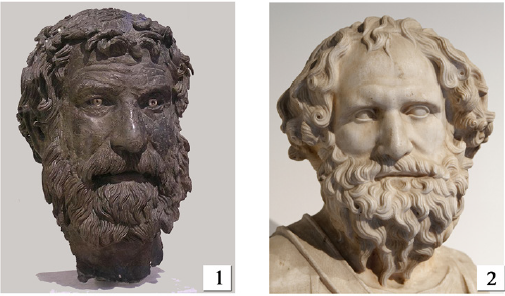
Figure 8: (a) Marble statue of a boy. Material: Parian marble. Provenance: Antikythera shipwreck. Athens, National Archaeological Museum; (b) The statue of “Antikythera Youth”. Material: Bronze. Provenance: Antikythera shipwreck. Athens, National Archaeological Museum, X 13396; (c) The Sounding-weight. Material: Lead. Provenance: Antikythera shipwreck. Height: 0.142 m, weight: 14.460 kg. Athens, National Archaeological Museum, X 19013.
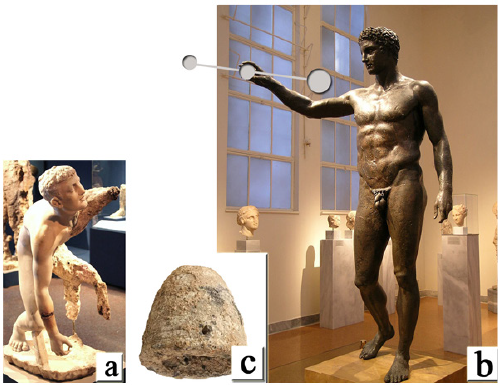
Also note that the name of Archimedes does not look like as a typical Syracuse, Sparta or Greek name, so the phrase that Archimedes was born in Syracuse, should be understood in a figurative sense as a famous and legendary person. Old Spartan sandals dressed on Cynic Philosopher feet are also symbolic as point to the Archimedes origin.
Due to the standard versions of the life of Archimedes were written long after his death by the historians of Ancient Rome, it should not be treated with great confidence. Plutarch wrote in his Parallel Lives that Archimedes was related to tyrants. Most of researchers believe that ones tyrant is King Hiero II, the ruler of Syracuse. However all Athenians Greeks thought that famous tyrants were Eurypontid kings and King Archidamos II/III is not exception. It is should be allowed, that Archimedes has relation to the Spartan tyrant, Archidamos II/III. The presence on the Antikythera Mechanism side the cities of Sparta and its allies at Peloponnesian Wars such as Ambrakia (Dodona) in the Epiros, Delphi in Phokis and Epidauros in the Peloponnese, confirms this hypothesis.
Also, note the next historical curiosity about Archimedes bust. The bust of Archidamos III, a king of Sparta 360 B.C.-338 B.C., in the Eurypontid dynasty, was found on the Villa of the Papyri in Herculaneum (Figure 9b). Now it presented in the National Archaeological Museum of Naples (Naples, Italy). During a long time this bust widely claimed to represent Archimedes. The reason why the bust of Archidamos III, which was none philosopher and aggressor against to Italy, was presented in the library of the Villa of the Papyri is not clear. Let’s note that Archidamos III was killed in the battle under the walls of Manduria, South Italy. Our hypothesis that Archimedes belongs to the clan of Archidamos may have a definite meaning. Note that there is some similarity between the bust of Archidamos III and the bust of Cynic philosopher, see Figure 9a&9b. In this situation it is clear why neither the Ancient Roman, nor the Ancient Greeks (Athenian) historians politically are favorable to describe the details of Archimedes life.
Figure 9: The two gravitational waves interference schemes: direct linear alignment scheme, also called as Archimedes Lever (a), one of the non- direct linear alignment schemes (b), in which Earth does not included in the planet alignment.
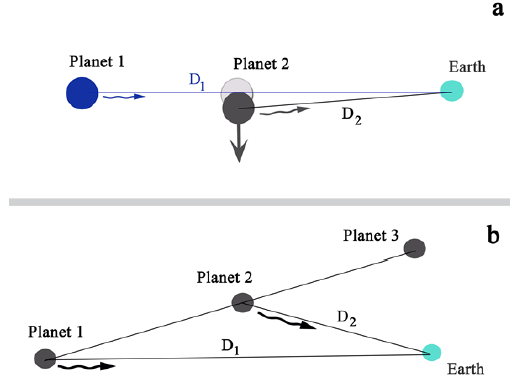
The Archimedes Lever at Antikythera Ship
At Antikythera shipwreck site the several statues were found. One of them was “Antikythera Youth”. The young, nude man is shown standing in a frontal pose, see Fig.10b. The figure raises and extends diagonally the right arm. His head is inclined strongly right, without focusing his gaze on the object he once held in his right hand. The “Antikythera Youth” has been variously interpreted: as Apollo; a Hermes holding a caduceus and declaiming; Heracles with club or lion-skin; a victorious Athlete holding as prize a spherical lekythion, a sphere, a wreathe, a phiale, or an apple; hero Perseus, displaying in his right hand the head of the Gorgon Medusa, grasping her by the hair or Trojan hero Paris, holding the Apple of Discord. The majority of scholars, who consider the “Antikythera Youth” a work of the Argive-Sicyonian school of successors to Polykleitos, would prefer to attribute it the Sicyonian Kleon, a sculptor of the “third generation” of the school’s artists [28] (Figure 8).
Let us return back to Peloponnese history. Before 245 B.C. Aratus turned to Ptolemy II, King of Egypt, to help him in the battles with King Antigonus II of Macedonia. Aratus sent from Argos to Ptolemy II the Greek paintings and sculptures, made by famous artists from Argos and Sicyon, in which were important centers of art. We assume that at the same time the Argos and Sicyon could send to Syracuse the sculpture of an “Antikythera Youth” demonstrating the Archimedes’ lever principle. Thus according our reconstruction a young man holds in the right hand an Archimedes lever or some another variant of weight balance, see Figure 10b.
Also it is interesting to see in other sculpture of “Marble statue of a boy” which also found at the Antikythera shipwreck, [28]. As remarked early, the figure is balanced between tension and relaxation. However, the most likely interpretation is that of a pancratiast or a wrestler was represented at the moment of assuming his position just prior to the match. His stance and expression assume the presence of a second opposing figure or audience. It is quite possible to assume that young boy without successfully tries to shift a heavy subject, Figure 10a.
Figure 10: (a) – Lion Hunting, “Orion and Lion” in the 29th constellation card from boxed set of 32 constellation cards of Urania’s Mirror, published by Samuel Leigh of the Strand, London, November 1824; (b) – The tree bright bluish stars (Alnitak, Alnilam, and Mintaka) which located in one line in the gorgeous cosmic vista, Google Earth; (c) – The alignment of Giza pyramids complex, satellite image from Google Earth; (d) – The fourth planet alignment during the strong volcanic eruption of Pinatubo (1991) with VEI=6.
Numbers: (1) – Orion belt; (2) – cudgel of hunter which is the analog of whip on frescoes in Fig.4a (this study) or is analog of flail (nekhakha) in Min cult which was prevalent at Early Bronze Age. The Orion belt principal also known as Orion– Pleiades, Kesil (Hebraic Dummy) belt was established in the pre-dynastic period in Coptos (Koptos) and Akhmim (Panopolis), Upper Egypt;
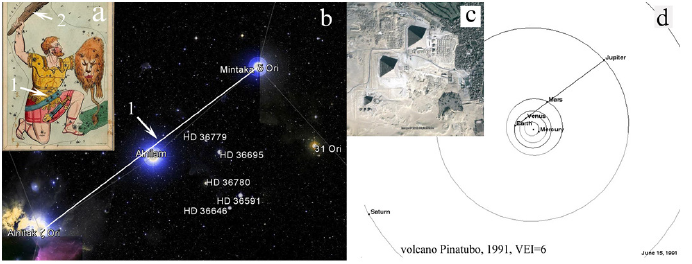
As it is well known, the two sounding-weights were recovered at the Antikythera shipwreck. One of them was presented in Figure 10c. Earlier researchers identified these objects as a soundingweight, a device used for measuring water depth and testing the seabed’s texture. However, one of these objects weighted 14.46 kg; a second was lighter with weight equal to 9.62 kg. The ratio of weights is equal to 1.503. A slight deviation from 3/2 was happened due to the loss of fastenings and due to the material corrosion for a long time presents at the bottom of the sea. Thus these two sounding-weights were used for demonstration the Archimedes lever principal for 3/2 relations.
Based on the subjects lifted from shipwreck unequivocal conclusion was made. The sculptures of “Antikythera Youth” and “Marble statue of a boy”, hidden in the library aboard a ritual unusual ship called Syracusan (later recalled to Alexandrian), demonstrated the principle of Archimedes Lever.
The Archimedes Lever as a Theoretical Basis of Roman Volcanology and Seismology
Return to the consideration of the scheme in Figure 6. There is no particular doubt in the presence of seismic tunnels, in the possibility of real time seismic observations by using these tunnels and in the near-real seismic forecasting (“guess at the bean”). From other hand also there is no doubt in the possibility of planet positions prediction by using ancient planet calculators such as Antikythera mechanism.
However it is rise up the next question: Whether planet alignment have an essential impact on the natural processes or not? (Figure 9)
The two gravitational waves interference schemes: direct linear alignment scheme, also called as Archimedes Lever (a), one of the non- direct linear alignment schemes (b), in which Earth does not included in the planet alignment were presented in Figure 9a&9b. The conflict between followers and opponents of above statement is extending more than several thousand years; from time to time it calm down and flush up again. This chronology of conflict was presented in Table 1.
Below we wrote some words about history of Orion-Pleiades principal. Bauval, Gilbert, Orofino and Bernardini investigated the similarity between Orion’s belt and locations of the three largest pyramids in the Giza pyramid complex, [29-31]. Bauval and Gilbert called this phenomenon as “Orion Correlation Theory” (OCT). However, such a coincidence does not reveal the physical seismic nature of the phenomena.
Also note in Bible’s Book the Orion belt also was referred with Pleiades in (Job 38:31): “Can you bind the chains of the Pleiades? Can you loosen Orion’s belt?” (1)
The constellation map of the Orion belt is often presented in the traditional interpretation as a Hunt Lion. In Figure 10a it was presented the constellation card of “Orion and Lion”, the 29th card from boxed set of 32 constellation cards of Urania’s Mirror, which was published by Samuel Leigh of the Strand, London, November 1824. Note that the cudgel of hunter is the analog of whip on frescoes in Figure 4 (this study) or is the analog of flail (nekhakha) in Min cult. The Min cult was prevalent at Early Bronze Age in the pre-dynastic period in Coptos (Koptos) and Akhmim (Panopolis), Upper Egypt.
The crook (heka) and flail (nekhakha) are symbols used in Ancient Egyptian society. Thus it is possible to assume that in Ancient Egypt the heka was using as astronomic tool to check pharaoh’s vision of Pleiades. During the inauguration process the Priest shown on constellation Pleiades by using heka and Pharaoh had to count the number of stars (Sisters) in this constellation. The flail (nekhakha) has rigid and sharp three tails (knives). On the next step of inauguration Priest lashed Pharaoh by nekhakha so on pharaoh back; the nekhakha left mark in the form of three stars in line, which imitated the Orion’s belt. Until now, not one Egyptologist could describe the meaning of heka and nekhakha. Thus in the Ancient Egypt the Pleiades - Orion principal probably called as a heka-nekhakha principal (Figure 10).
The tree bright bluish stars (Alnitak, Alnilam, and Mintaka) which located in one line in the gorgeous cosmic vista was presented in details by Google Earth-Sky Map in Figure 10b. For us is important that three stars formed one line on the dome of the sky. Further for comparison we show the alignment of Giza pyramids complex by the Google Earth satellite image (Digital Globe), see Figure 10c. At last the fourth planet linearity during the strong volcanic eruption of Pinatubo (1991) was represented in Figure 10d. The powerful Pinatubo eruption was happened at 15 July 1991 with VEI 5. During this strong eruption the huge volcanic ash volume was emitted in a stratosphere so it reduces the downstream solar radiation and cooled the Earth’s surface during the next 3 years. We have clearly demonstrated the relationship between the position of the stars (in the reality the planets), the location of the Giza pyramids, a Hunt Lion and such a physical phenomenon as a strong volcanic eruption.
Since we have already mentioned about the Hunt Lion, we have to write a few words about it. Tutankhamen 1341-1323 B.C. was an Egyptian pharaoh of the 18th dynasty during the period of Egyptian history known as the New Kingdom. The term “Hunt Lion” is associated with the death of Tutankhamen. Now we can accurately indicate the time and place of Pharaoh’s death. Tutankhamen died during the inauguration process, in the Chamber of the Kings inside the pyramid of Cheops. Tutankhamen almost instantly due to injuries caused a seismic ball(s) and possibly their anchorage system, located in the so-called pyramid ventilation shaft. The ball, moving with high speed as cannon ball, hit Pharaoh in the right half of his chest, threw his body to the opposite wall and knocked over the oil lamps, which lighted the Chamber of the Kings. Spilled burning oil caused burns of the Pharaoh’s body. Further the ball reflected from the opposite wall, struck and completely destroyed the left front corner of the pedestal, which sometimes was called as pharaoh’s sarcophagus. During the inauguration a Lion monument was sitting on this pedestal; this Lion was depicted in the many Egyptian frescoes. Due to the ball stuck in the pedestal and possibly the Lion monument, after 18th dynasty the process of pharaoh’s inauguration sometimes was named a Lion Hunt. Note that the law of damnatio ad bestias as a religion punishment (Leges duodecim tabularum) was using in Rome only under Vespasian and Titus i.e. after the Roman-Judaic wars. Thus we see how this Roman law came from the Ancient Egyptian and Hebraic history.
Recently, the fate of Nefertiti (Neferneferuaten) has been widely debated among Egyptologists. Note that the left wall in the Kings Chamber of Cheops Pyramid was covered with soot. Nefertiti, as a regent of Tutankhamun, should be present on his inauguration. If she did attend the inauguration, she could get a serious burn on the left side of her body. Whether she died with Tutankhamun or she was seriously injured by the lamp burning oil, this matter requires further investigation. However, the discovery of lovely Nefertiti bust, rather indicate that she was severely burned, so a puppet (Nefertiti-doll) was used instead of her in the palace ceremonies. Note that neither before nor after the Nefertiti-Tutankhamun reign such realistic busts were not discovered in Egypt.
Time is passing; new centuries and new conceptions were coming. The ancient astronomers in Egypt did not make a significant difference between stars and planets. The planets were seen as the driving stars. Later ancient astronomers began to separate planets and stars. Therefore Thales Milesian and Pythagoras was used Orion principle only to the planet alignments. However, the planets are moving in the sky, so the second part about the angular resolution, which must less that the angular resolution of the constellation of Pleiades, was disappeared of the Orion belt principal without a trace.
At the time of the eruption of Mount Vesuvius, the Orion belt principal was defined as Archimedes Lever principle. According to Pappus of Alexandria, expression of Archimedes Lever is next:
“Give me a place to stand and with a lever I will move the whole world.” (2)
The scheme of Archimedes’ Lever using for planets was demonstrated in Figure 11b which obtained from Mechanics Magazine, London, 1824 (Figure 11 ).
Figure 11: (a) -– The E V Mr planet alignment for the volcanic (Vesuvius, 1631) eruption; (b) – the illustration of Archimedes’ levers, obtained from Mechanics Magazine, which was published in London in 1824.
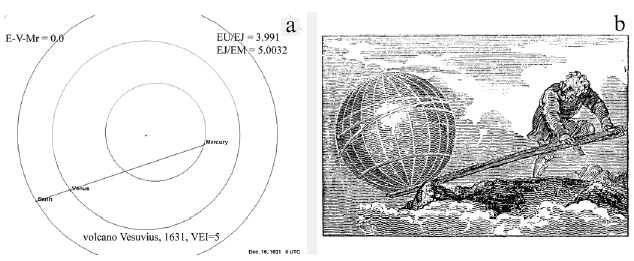
In this study, the case of the volcanic eruption of Vesuvius at A.D. 79 was investigated. There is an opinion that the volcano erupted on 24 August, but Rolandi et al put forward a hypothesis that the eruption occurred on 24 October [1]. Arguments of Rolandi et al cannot be called very convincing, as at civil constructions it can indicate not only the date of building started date, but also it can indicate the date of building expiry date. Second, at the volcano eruption the stratification of the atmospheric layers is broken, a convective super cell can forms and the cold air from the upper cold layers of the troposphere can flows down to the land surface. This effect is local and can be observed at a distance of 10-40 km from the vent of the volcano on the leeward side. Thirdly, the additional study, carried out by the author, has shown that the probability of strong volcanic eruption in August is higher than the probability of an eruption in November.
Due to the uncertainty with the eruption date, the Archimedes’ lever application will be illustrated on another example of the powerful eruption of Vesuvius with VEI 5 at 16 December 1963. Apparently from Figure 11a, at the time of a powerful eruption is correlated with a linear configuration of the EarthVenusMercury (EVMr). The ratio of distance between EarthJupiter and EarthMars (EJ/EM) is close to integer value and equal to 5.003. It is possible specifies that interaction has gravitation nature with coherence, which inherent to the wave processes.
Some skeptical scientists may say that the planetary alignment shown in Figure 10d&11b is a casual coincidence. Therefore, we give more four examples of strong volcanic eruptions which corresponding to planet alignment, see Figure 12. Due to the volcanic eruptions are the subjects in this study, the cases of strong earthquakes are not considered.
The examples of volcanic eruption with SEV and SME planet alignment (Agung, 1963) and (Chiron, 1982) were presented on Figure 12a&b. The planet alignment for volcano Agung eruption with VEI 5 was reached at 3:00 UTM, 17.03.1963 and planet linearity for volcano Chiron eruption with VEI 4+ was reached at 1:00 UTM, 28.03.1982. The ratios of distances are ES/EV=10.035 and EM/EV=0.997, accordingly.
Figure 12: The Saturn–Venus–Earth and Saturn–Mars–Earth planet alignments corresponded to strong volcano eruptions: Agung (1963), (a) and Chiron (1982), (b). The samples of volcanic eruptions with planet alignment, which none include Earth: Tolbachik (1975), (c) and St. Helen (1980), (d).
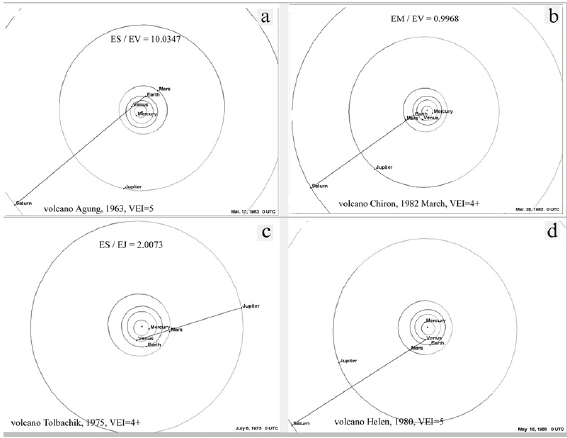
The examples of volcanic eruption with planet alignment, which none include Earth (Tolbachik, 1975), (St. Helen, 1980) were presented on Fig.12cd. The JMV planet linearity for volcano Tolbachik eruption with VEI 4+ was reached at 21:00 UTM, 06.07.1975 and SMV planet linearity for volcano St. Helen eruption with VEI 5 was reached at 2:00 UTM, 18.05.1980. The ratios of distances characterizing wave processes, are equal to ES/EJ=2.007 and EJ/EMr=4.044, respectively.
The volcanic eruption is a long term processes. The comparison of time of volcano eruption with the process of planetary linearization obviously leads to fewer coincidences due to a fact that sometimes the preeruption activity was recorded. In this situation it is not surprised that the better correlation was observed for the large eruptions of explosive type and for strong earthquakes. As the Archimedes Level inherited from Moses Orion-Pleiades principal we must wrote several words about Red Sea Crossing, (Exodus 14: 16-17). The text of Exodus has late distortions, but meaning of words is obvious. Moses guessed that the activation of the seismic fault along the Gibraltar-Rhodes line, which took place in the 12 century B.C., may not be associated with geological processes on the fault, extended along the Red Sea. The idea came to Moses when he was studying rifts from a top of unnamed hill, on the shore of Red Sea, in the Sinai Peninsula, where faults are most noticeable. Therefore in the Exodus it was written about Sinai as Peninsula and accordingly it is clear that this unnamed hill on the shore of Red Sea is not Mount Sinai. The Red Sea split and it made the religious complex in Giza absolutely useless. In this way, due to Red Sea was split and trick with Egyptian horse cavalry was let out, the choice is not great, either the lifetime slavery in the Egyptian stone quarries or Exodus.
Also we highlighted that up-to-date historians realized an Exodus in a sense of peculiar Hebraic marathon. In a reality the Exodus was a grandiose Moses project to create a system of twelve seismoacoustics stations (also known as a twelve knees/branches), allocated in the both sides along the fault from Aquaba to Nabatieh. This new religion complex in Ancient Egypt should replace old, useless Giza Pyramid’s Complex. Note that in the 12 century BC the area between Aquaba and Ugarit was territory of Ancient Egypt or under it control.
Discussion About Planet Alignment
In this section we will discuses about correlation between planet alignment (called above as planetary Archimedes Lever) and the volcanic eruptions and the earthquakes. After reconstruction of Jerusalem Second Temple by Herod I the relations between Essenes (the Jewish Pythagoreans) and Sadducees (priests in the Jerusalem Temple) sharply deteriorated. Disputes mentioned such issues, as washing legs before visiting the Holy places (meaning: walking on water, i.e. following the traditions of Moses); frauds with first spin, extra virgin olive oil (meaning: incorrect using of the Moses` Menorah as an ancient astronomical tool); Remoh wedding dancing with stars (see above, this study); about Moses` inheritance (meaning: promissory note); the carry out of public sexual orgies (meaning: Sodom and Gomorrah, Hebrew Bible). These issues such as next: rights of the Jews to the land of Israel; Holy Court; legitimacy of the Jerusalem Second Temple; Exodus and Bronze Age Holocaust are beyond the scope of this study. We encourage readers to see special studies of experts of the Middle East and Ancient Egypt.
Very important note that the confrontation between opponents and followers of Moses, and later between Early Christians and the Roman philosophers, creates an extremely negative background for the studying of Archimedes’ Level principal and Pythagoras- Platonic cosmology, which are heritable from Moses` Orion- Pleiades principal.
We will not stop on the opinion of opponents who deny the existence of Plato, Pythagoras or Archimedes. Unfortunately, we met such scientists more than once. However there is another big community of scientists who deny the planet alignment effects. They are theorists of astrophysics, Einstein’s followers. Note that Einstein axiomatics is the Achilles’ heel of the general theory of relativity. If the axiomatics is not true, then all studies of the general theory of relativity automatically become a fake. Hence our opponents zealously try to prevent the publication of facts of planet alignment; to close physical journal, in which published an opposite opinion; pushed to press own strangeness results of LIGO and VIRGO Team, in which the neutron stars suddenly become a source of super short pulses of gravitational waves; these researchers openly lobbying own interests in the Nobel Committee. Now the reader may ask LIGO Team: where the promised and advertised collision of two black holes was? However these scientists are queerly silent. At the same time these scientists always consider themselves right.
Note that the presence of the planet alignment effect was reported not only the author of this study (Figures 10b, 11 and 12), but also by the other researchers. Note that the effect is global and manifests itself in the different forms both on the Earth and on the Sun. In 1971 Gribben suggested that earthquakes were correlated with sunspots or planetary alignments [32]. Later Gribben also claimed that the level of solar cycle activity is influenced by the alignments of the planets, through tidal interactions with the Sun [33]. The effect of planet alignments on the earthquakes and sunspots was called as “Jupiter effect”, a name coined for the heliocentric alignment of all the planets on the same side of the Sun [34]. Several criticisms on Jupiter effect were published by Meeus, Ip and Hughes, [35-37] with replies of Gribben and Plagemann [38- 40]. Also Geller in 1997 wrote a critical review about earthquake prediction [41].
In many studies the attempts were performed to find a way out of the situation. However, it is necessary to notice that mostly researches used the tidal effect of the Venus-Earth-Jupiter interaction, [42-52]. The geophysicist’s community conclusion on planetary-solar-terrestrial interaction was summarized in Mörner et al study, [53].
While we wrote about possibility of earthquake or volcano eruption prediction, we did not absolutize our results. The planet alignment is the only trigger of seismic and volcanic processes. It is well known that earthquakes can be caused by other factors, both natural and man-made. For example, the earthquakes can be initiated by lunar tide, by filling of large water storage reservoir, by shale fuel production or by underground nuclear testing. So if an earthquake or a volcanic eruption occurred, it may be is not have any relations to the planet alignment.
On the other hand, the earthquakes and eruptions are complex geological processes. For their occurrence, the certain conditions in lithosphere must be presented. Therefore, it is possible that the planet alignment can take place, but the earthquakes or eruptions will not happen, due to the critical conditions of seismic or volcanic processes have not been created in the earth’s crust.
Thirdly, the earthquake predictions must be local (see text above about Cumaean Sibyl), while the planet alignment is a global process. You are waiting for a volcano eruption or an earthquake in Pompeii, but it happens on the other side of the Earth, in Peru or in California.
Fourthly, now we know little about the process of planet alignment. We indicated the distance between the planets. It turned out that in many cases the ratio of distances is close to integer values. This gives us a clue that we are dealing with the interference of gravitational waves or vortices. Therefore we will give an effect only at maximum or minimum of interference, while most of planet alignment will occur without any visible consequences. Based on the above, it should be realized that not every planet alignment will lead to significant effects in the earth’s lithosphere (atmosphere) or lead to changes in the solar activity.
Let’s summarize the discussion. The Pythagoras-Plato gravitational waves (String Theory of Gravity) have been known in Europe since the times of Thales of Miletus and Pythagoras. In the modern world, the effect of the planet alignment was recognized by Kepler. However, most of present-day astronomers deny the presence of effects at the planets alignment. It is a principal cause of a writing of this article. Ones should be a stupid not to check up the presence effect of the planet alignment; ones should be an ignoramus not to know that presence effect was known even in the Old Testament and early in the Ancient Egypt as Orion Belt Principal. The presumptive frequency range of Pythagoras-Plato gravitational waves (more precisely Pythagoras-Plato vortex) was presented in Figure 13.
Conclusion
A number of studies related to the of the Vesuvius volcano eruption at 79 AD have been carried out. The detailed analysis of the Villa of Mysteries frescoes was performed. It was shown that Villa of Mysteries is a small school of priestesses-seismologists. It is established that the frescoes depicts the process of priestesses introducing in the Hera seismoacoustics cult (more precisely, the Zeus-Hera-Dionysus cult). It is shown that in the Hera cult the wand strike on the back of the graduate prieststudent symbolizes the fact of the introduction of the priestesses to the priesthood. A comparison between the Pythagoras School in the Crotone, southern Italy (located in the Temple of the Muse) and the small school at Villa of Mysteries was carried out. In addition, it was shown that Pythagorean-Platonic cosmology was developed and generalized by Archimedes.
Detail analysis of sculptures which lifted up from sunken Antikythera ship was carried out. It was shown that the Cynical Philosopher is well-known Philosopher with wet hair, which once exclaimed Eureka! Thus we assumed that Archimedes was an author of Antikythera Mechanism. Two sculptures of “Antikythera Youth” and “Marble statue of a boy”, hidden in the library aboard Antikythera ship, also demonstrated the principle of Archimedes Lever. It was presented that the Antikythera ship was the ritual unusual ship, which originally was named as Syracusan and later it was recalled to Alexandrian.
The Pliny Younger and Suetonius letters was investigated. It was supposed that “Rectina, the wife of Bassus” was wife of Gaius Laecanius Bassus Caecina Flaccus, grand sun of well-known Gaius Laecanius Bassus (consul A.D. 64). Also it was supposed that Pliny Eld did not die in the Stabiae, but he perished in the Pompeii, in the House of the Gold Bracelet (Insula 17, 42), which was property of Bassus family.
Egyptologists were glad to known that Tutankhamen died during the inauguration process, in the Chamber of the Kings inside the pyramid of Cheops (sometime called as Hunt Lion). Hellenists none less were amazed to know that Homer is the name of a cult Semitic dance (Remoh) with a tambourine (two six-ray stars), and accordingly it is not the name of author of magnificent poems. The poems was writing by Moses (12 century B.C.) and rewriting by poetess Helen (Evenus) of Paros (4 century B.C.). Undoubtedly Helen of Paros knew that Semitic texts are written from right to left and she as a joke represented us a simple word-play: Remoh- Homer.
At the last stage of the study it is shown that Pythagorean- Platonic cosmology and Archimedes Lever Principal are the theoretical basis of the volcanology of the Roman Empire. The possibility of using Archimedes Lever Principal for forecasting eruptions was demonstrated in several examples of the large explosive eruptions with VEI greater than 4+. It was shown that strong volcano eruptions with VEI>4+ (6 examples) are corresponded to the planets alignment. It was noted that the Pythagoras-Plato gravitational waves were known in Europe since the times of Thales of Miletus and Pythagoras. The new interpretation of Third Law of Motion was presented in Appendix. Now the spacecrafts using the principle of jet propulsion can not fly too far from our planet. At the same time, in this study it is shown that Pythagoras-Plato vortex has significant energy. In the future, the energy of this vortex can be used in the galactic and intergalactic space missions.
Acknowledgement
Author is indebted to the Ancient Roman and Greece philosophers, astronomers, mathematics and poets for teaching how to make the great discoveries. Article is devoted to my wife inspired me on its writing.
Appendix
According to the Archimedes Lever principal the Third Law of Motion must be changed by adding several words to the end of the law text:
“When one body exerts a force on a second body, the second body exerts a force equal in magnitude and opposite in direction to that of the first body in the absence of obstacles in the path between these bodies”
The other interpretation was considered:
“When in a vacuum or in a homogeneous and isotropic medium one body exerts a force on a second body, the second body exerts a force equal in magnitude and opposite in direction to that of the first”.
References
- Rolandi G, Paone A, Lascio MD, Stefani G (2007) The 79 AD eruption of Somma: The relationship between the date of the eruption and the southeast tephra dispersion. Journal of Volcanology and Geothermal Research 169: 87-98.
- Sigurdsson H, Cashdollar S, Sparks SRJ (1982) The Eruption of Vesuvius in A. D. 79: Reconstruction from Historical and Volcanological Evidence. American Journal of Archaeology 86: 39-51.
- Luongo G, Perrotta A, Scarpati C (2003) Impact of the AD 79 explosive eruption on Pompeii, I. Relations amongst the depositional mechanisms of the pyroclastic products, the framework of the buildings and the associated destructive events. Journal of Volcanology and Geothermal Research 126: 201-223.
- Lirer L, Pescatore T, Booth B, Walker GPL (1973) Two Plinian Pumice-fall Deposits from Somma-Vesuvius, Italy. Bulletin of the Geological Society of America 84(3): 759-772.
- Mastrolorenzo G, Petrone P, Pappalardo L, Guarino FM (2010) Lethal Thermal Impact at Periphery of Pyroclastic Surges: Evidences at Pompeii. PLoS ONE 5: e11127.
- Safronov AN (2016) Antikythera Mechanism and the Ancient World. Journal of Archaeology.
- Pliny Y To Tacitus”, LXV Letters of Pliny.
- Pliny Y To Cornelius Tacitus, LXVI. Letters of Pliny.
- Suetonius The Life of Pliny. The Lives of the Twelve Caesars, Esq., A.M.
- Maiuri A (1978) The room plan of Pompeii Villa of Mysteries or Villa dei Misteri. The plan and interpretation of the rooms was based on Pompeii by Amedeo Maiuri, (15th Edn). Istituto Poligrafico dell Stato pp. 97-101.
- Osamu A, Ron B, Osamu Ajiki (1996) “OrbitViewer applet”.
- JPL Small-Body Database Browser NASA, California Institute of Technology, Jet Propulsion Laboratory (JPL), JPL Small-Body Database Browser, Orbit Diagram.
- Newhall CG, Self S (1982) The volcanic explosivity index (VEI): An estimate of explosive magnitude for historical volcanism. Journal of Geophysical Research 87: 1231-1238.
- Siebert L, Simkin T, Kimberly P (2012) Volcanoes of the World. University of California Press,
- Datasets: (2012) Datasets, Smithsonian National Museum of Natural History. Washington DC, USA.
- Orsi G, Di Vito MA,Isaia R (2004) Volcanic hazard assessment at the restless CampiFlegrei caldera. Bulletin of Volcanology 66(6): 514-530.
- AulinasM, Civetta L, Di Vito MA, Orsi G, Gimeno D, et al.(2008) 'The “Pomici di mercato” Plinian eruption of Somma-Vesuvius: Magma chamber processes and eruption dynamics. Bulletin of Volcanology 70: 825-440.
- Di Vito MA, Piochi M, Mormone A,Tramelli A (2011)Somma Vesuvius: The Volcano and the Observatory. Field trip guidebook - REAKT, Via Nuova Agnano, Naples, Italy.
- Plutarque Sur les Oracles de la Pythie.
- Homer (1887) Odyssey of Homer. vol I, Book 1, Reeves and Turner, London, United Kingdom p. 52.
- Cioni R, Pistolesi M,Rosi M (2015) Plinian and Subplinian Eruptions. H Sigurdsson et al. (Eds.), The Encyclopedia of Volcanoes pp. 519-535.
- Cioni R, Gurioli L, Lanza R,Zanella E (2004) Temperatures of the A.D. 79 pyroclastic density current deposits (Vesuvius, Italy). Journal of Geophysical Research 109: B02207 1-18.
- Shea T, Gurioli L, Houghton BF, Cioni R, Cashman KV (2011) Column collapse and generation of pyroclastic density currents during the A.D. 79 eruption of Vesuvius: The role of pyroclast density. Geology 39: 695-698.
- Luongo G, Perrotta A, Scarpati C, De Carolis E, Patricelli G, et al.(2003) Impact of the AD 79 explosive eruption on Pompeii, II. Causes of death of the inhabitants inferred by stratigraphic analysis and areal distribution of the human casualties. Journal of Volcanology and Geothermal Research 126: 169-200.
- Lehmann K (1962) Ignorance and Search in the Villa of the Mysteries. The Journal of Roman Studies 52(1-2): 62-68.
- Iversen PA (2017) The Calendar on the Antikythera Mechanism and the Corinthian Family of Calendars. The Journal of the American School of Classical Studies, Athens, Greece 86(1): 129-203.
- The Canopus Decree (6 March 238 BC) Records of the Past. Samuel Bagster and Sons, London, United kingdom.
- Kaltsas N, Vlachogianni E,Bouyia P (2012) The Antikythera Shipwreck, Τhe Ship - The Treasures - The Mechanism.Catalogue of the Archaeological Exhibition, National Archaeological Museum.
- Bauval RG, Gilbert A (1994) The Orion Mystery. Oxford, England
- Bauval RG (2006) The Egypt Code. London, United Kingdom.
- Orofino V,Bernardini P (2016)Archaeoastronomical Study of the Main Pyramids of Giza, Egypt: Possible Correlations with the Stars?. Archaeological Discovery 4: 1-10.
- Gribben J (1971) Relation of sunspot and earthquake activity. Science 173(3996): 558.
- Gribben J (1973) Planetary Alignments, Solar Activity and Climatic Change. Nature 246: 453- 454.
- Gribben JR,Plagemann SH (1974) The Jupiter Effect. London, United kingdom.
- Ip WH (1976)Chinese records on the correlation of heliocentric planetary alignments and earthquakes activities. Icarus 29: 435-436.
- Meeus J (1975) Comments on The Jupiter Effect. Icarus 26, 257-267.
- Meeus J (1975) Reply to Grihben and Plagemann. Icarus 26: 270.
- Gribben J (1975) Predicting earthquakes. Physics Today 28: 13-15.
- Gribben J,Plagemann S (1975)Response to Meeus. Icarus 26: 268-269.
- Gribben J (1976) The author comments. Physics Today 29: 11-13.
- Geller RJ (1997) Earthquake prediction: A critical review.Geophys J Int 131: 425-450.
- Abreu JA, Beer J, FerrizMas A, McCracken KG,Steinhilber F (2012) Is there a planetary influence on solar activity?Astron Astrophys 548(A&A): A88 9.
- Bollinger CJ (1952) A 44.77 year Jupiter–Venus–Earth configuration Sun-tide period in solar-climatic cycles. Proc Okla Acad Sci 33: 307.
- Condon JJ, SchmidtRR (1975) Planetary tides and the sunspot cycles. Solar Phys 42: 529-532.
- Hung CC (2007) Apparent relations between solar activity and solar tides caused by the planets. NASA/TM-2007-214817.
- Okhlopkov VP (2014) The 11-year cycle of solar activity and configurations of the planets. Moscow Univ Phys Bull 69: 257-262.
- Scafetta N (2010) Empirical evidence for a celestial origin of the climate oscillations and its implications. J Atmos Solar-Terr Phys 72(13): 951-970.
- Scafetta N (2014) The complex planetary synchronization structure of the solar system. Pattern Recogn Phys 2: 1-19.
- Stefani F, Giesecke A, Weber N,Weier T (2016) Synchronized Helicity Oscillations: A Link Between Planetary Tides and the Solar Cycle?. Solar Phys 291: 2197-2212.
- Takahashi K (1968) On the relation between the solar activity cycle and the solar tidal force induced by the planets. Solar Phys 3: 598-602.
- Wilson IRG (2013) The Venus-Earth-Jupiter spin-orbit coupling model. Pattern RecognPhys 1: 147-158.
- WoodK (1972) Sunspots and planets. Nature 240: 91-93.
- Mörner NA, Tattersall R, Solheim JE, Charvatova I, Scafetta N, et al. (2013) General conclusions regarding the planetary-solar-terrestrial interaction. Pattern Recognition in Physics 1: 205-206.

Top Editors
-

Mark E Smith
Bio chemistry
University of Texas Medical Branch, USA -

Lawrence A Presley
Department of Criminal Justice
Liberty University, USA -

Thomas W Miller
Department of Psychiatry
University of Kentucky, USA -

Gjumrakch Aliev
Department of Medicine
Gally International Biomedical Research & Consulting LLC, USA -

Christopher Bryant
Department of Urbanisation and Agricultural
Montreal university, USA -

Robert William Frare
Oral & Maxillofacial Pathology
New York University, USA -

Rudolph Modesto Navari
Gastroenterology and Hepatology
University of Alabama, UK -

Andrew Hague
Department of Medicine
Universities of Bradford, UK -

George Gregory Buttigieg
Maltese College of Obstetrics and Gynaecology, Europe -

Chen-Hsiung Yeh
Oncology
Circulogene Theranostics, England -
.png)
Emilio Bucio-Carrillo
Radiation Chemistry
National University of Mexico, USA -
.jpg)
Casey J Grenier
Analytical Chemistry
Wentworth Institute of Technology, USA -
Hany Atalah
Minimally Invasive Surgery
Mercer University school of Medicine, USA -

Abu-Hussein Muhamad
Pediatric Dentistry
University of Athens , Greece

The annual scholar awards from Lupine Publishers honor a selected number Read More...




